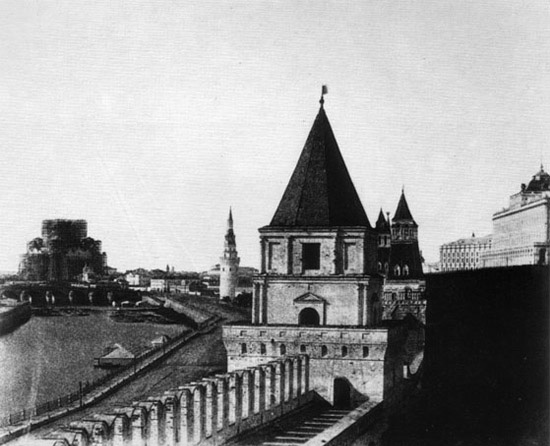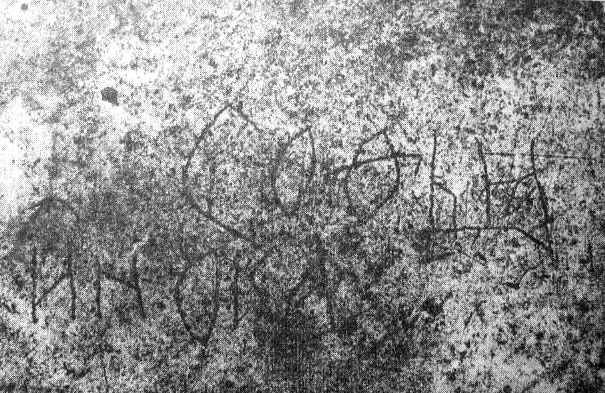|
Lenin Hills
Sparrow Hills (russian: :ru:Воробьёвы горы, Воробьёвы го́ры, ), formerly known as Lenin Hills (, ) between 1935 and 1999, is a hill on the right bank of the Moskva River and one of the highest points in Moscow, reaching a height of above the river level. The observation platform, which gives a good panoramic view of the city, is on a steep bank above the river, or above sea level. The Luzhniki Stadium (formerly the Lenin Stadium), where the opening and closing ceremonies for the 1980 Summer Olympics took place, is right below, across the Moskva River. Next to it is the Novodevichy Convent, with its Naryshkin Baroque towers. Not far from the observation platform is the Luzhniki Metro Bridge. The two-level Metro-Bridge traverses the river to link Komsomolsky Prospekt with Vernadsky Prospekt. It serves two urban transport systems: motor vehicles and the Moscow Metro subway. The glass-walled subway station ''Vorobyovy Gory (Moscow Metro), Vorobyovy Gor ... [...More Info...] [...Related Items...] OR: [Wikipedia] [Google] [Baidu] |
Main Building Of Moscow State University
The main building of Moscow State University (in Russian ''Гла́вное зда́ние МГУ'') a , 36-level (in its central part) skyscraper in Moscow, Russia. Designed by Lev Rudnev as the headquarters of Moscow State University, it is the tallest of seven Moscow skyscrapers in the Stalinist architectural style constructed between 1947 and 1953. It was until 1990 the tallest building in Europe before being surpassed by the Messeturm in Germany. It remains the tallest educational building in the world. Features The skyscraper has 36 levels in its central part and is tall. Its roof () is topped by a 58-metre spire which ends with a 12-ton five-pointed star. Lateral towers are lower than the central one; two 18 and 9 storey dormitory wings define, with the central corpus of the complex, a ''cour d'honneur'' courtyard. Among the statues which decorate the building is a sculpture by Vera Muchina representing a couple of students and a statue by N. Tomsky of Mikhail Lomono ... [...More Info...] [...Related Items...] OR: [Wikipedia] [Google] [Baidu] |
Vorobyovy Gory (Moscow Metro)
Vorobyovy Gory (russian: Воробьёвы го́ры, lit. ''Sparrow Hills'') is a Moscow Metro station. It is on the Sokolnicheskaya Line, between Universitet and Sportivnaya stations. Its name originates from a nearby elevated area literally translated as Sparrow Hills. History The bridge, which is known as the Luzhniki Metro Bridge, or simply "Metromost", and spans the Moskva River The Moskva (russian: река Москва, Москва-река, ''Moskva-reka'') is a river running through western Russia. It rises about west of Moscow and flows roughly east through the Smolensk and Moscow Oblasts, passing through centra ..., was originally built in 1958. The architects for the project were M. P. Bubnov, A. S. Markelov, M. F. Markovsky, A. K. Ryzhkov, and B. I. Tkhor. The bridge, hastily built, was plagued by corrosion and seeping water and fell into disrepair. It was deemed structurally unsound by 1984, so the station (at the time called L ... [...More Info...] [...Related Items...] OR: [Wikipedia] [Google] [Baidu] |
Moscow State University
M. V. Lomonosov Moscow State University (MSU; russian: Московский государственный университет имени М. В. Ломоносова) is a public research university in Moscow, Russia and the most prestigious university in the country. The university includes 15 research institutes, 43 faculties, more than 300 departments, and six branches (including five foreign ones in the Commonwealth of Independent States countries). Alumni of the university include past leaders of the Soviet Union and other governments. As of 2019, 13 List of Nobel laureates, Nobel laureates, six Fields Medal winners, and one Turing Award winner had been affiliated with the university. The university was ranked 18th by ''The Three University Missions Ranking'' in 2022, and 76th by the ''QS World University Rankings'' in 2022, #293 in the world by the global ''Times Higher World University Rankings'', and #326 by ''U.S. News & World Report'' in 2022. It was the highest-ran ... [...More Info...] [...Related Items...] OR: [Wikipedia] [Google] [Baidu] |
The Kremlin
The Kremlin ( rus, Московский Кремль, r=Moskovskiy Kreml', p=ˈmɐˈskofskʲɪj krʲemlʲ, t=Moscow Kremlin) is a fortified complex in the center of Moscow founded by the Rurik dynasty. It is the best known of the kremlins (Russian citadels), and includes five palaces, four cathedrals, and the enclosing Kremlin Wall with Kremlin towers. In addition, within this complex is the Grand Kremlin Palace that was formerly the Tsar's Moscow residence. The complex now serves as the official residence of the President of the Russian Federation and as a museum with almost 3 million visitors in 2017. The Kremlin overlooks the Moskva River to the south, Saint Basil's Cathedral and Red Square to the east, and the Alexander Garden to the west. The name "''Kremlin''" means "fortress inside a city", and is often also used metonymically to refer to the government of the Russian Federation. It previously referred to the government of the Soviet Union (1922–1991) and its highest ... [...More Info...] [...Related Items...] OR: [Wikipedia] [Google] [Baidu] |
Cathedral Of Christ The Saviour
The Cathedral of Christ the Saviour ( rus, Храм Христа́ Спаси́теля, r=Khram Khristá Spasítelya, p=xram xrʲɪˈsta spɐˈsʲitʲɪlʲə) is a Russian Orthodox cathedral in Moscow, Russia, on the northern bank of the Moskva River, a few hundred metres southwest of the Kremlin. With an overall height of , it is the third tallest Orthodox Christian church building in the world, after the People's Salvation Cathedral in Bucharest, Romania and Saints Peter and Paul Cathedral in Saint Petersburg, Russia. The current church is the second to stand on this site. The original church, built during the 19th century, took more than 40 years to build, and was the scene of the 1882 world premiere of the ''1812 Overture'' composed by Tchaikovsky. It was destroyed in 1931 on the order of the Soviet Politburo. The demolition was supposed to make way for a colossal Palace of the Soviets to house the country's legislature, the Supreme Soviet of the USSR. Construction starte ... [...More Info...] [...Related Items...] OR: [Wikipedia] [Google] [Baidu] |
Alexander I Of Russia
Alexander I (; – ) was Emperor of Russia from 1801, the first King of Congress Poland from 1815, and the Grand Duke of Finland from 1809 to his death. He was the eldest son of Emperor Paul I and Sophie Dorothea of Württemberg. The son of Grand Duke Paul Petrovich, later Paul I, Alexander succeeded to the throne after his father was murdered. He ruled Russia during the chaotic period of the Napoleonic Wars. As prince and during the early years of his reign, Alexander often used liberal rhetoric, but continued Russia's absolutist policies in practice. In the first years of his reign, he initiated some minor social reforms and (in 1803–04) major liberal educational reforms, such as building more universities. Alexander appointed Mikhail Speransky, the son of a village priest, as one of his closest advisors. The Collegia were abolished and replaced by the State Council, which was created to improve legislation. Plans were also made to set up a parliament and sign a constitu ... [...More Info...] [...Related Items...] OR: [Wikipedia] [Google] [Baidu] |
Boyars
A boyar or bolyar was a member of the highest rank of the feudal nobility in many Eastern European states, including Kievan Rus', Bulgaria, Russia, Wallachia and Moldavia, and later Romania, Lithuania and among Baltic Germans. Boyars were second only to the ruling princes (in Bulgaria, tsars) from the 10th century to the 17th century. The rank has lived on as a surname in Russia, Finland, Lithuania and Latvia where it is spelled ''Pajari'' or ''Bajārs/-e''. Etymology Also known as bolyar; variants in other languages include bg, боляр or ; rus, боя́рин, r=boyarin, p=bɐˈjærʲɪn; ; ro, boier, ; and el, βογιάρος. The title Boila is predecessor or old form of the title Bolyar (the Bulgarian word for Boyar). Boila was a title worn by some of the Bulgar aristocrats (mostly of regional governors and noble warriors) in the First Bulgarian Empire (681–1018). The plural form of boila ("noble"), ''bolyare'' is attested in Bulgar inscriptions [...More Info...] [...Related Items...] OR: [Wikipedia] [Google] [Baidu] |
Vitovt
Vytautas (c. 135027 October 1430), also known as Vytautas the Great ( Lithuanian: ', be, Вітаўт, ''Vitaŭt'', pl, Witold Kiejstutowicz, ''Witold Aleksander'' or ''Witold Wielki'' Ruthenian: ''Vitovt'', Latin: ''Alexander Vitoldus'', Old German: ''Wythaws or Wythawt'') from the late 14th century onwards, was a ruler of the Grand Duchy of Lithuania. He was also the Prince of Grodno (1370–1382), Prince of Lutsk (1387–1389), and the postulated king of the Hussites. In modern Lithuania, Vytautas is revered as a national hero and was an important figure in the national rebirth in the 19th century. ''Vytautas'' is a popular male given name in Lithuania. In commemoration of the 500-year anniversary of his death, Vytautas Magnus University was named after him. Monuments in his honour were built in many towns in the independent Lithuania during the interwar period from 1918 to 1939. It is known that Vytautas himself knew and spoke in the Lithuanian language with Jogaila. ... [...More Info...] [...Related Items...] OR: [Wikipedia] [Google] [Baidu] |
Sophia Vitovtovna
Sophia of Lithuania (1371–1453), also known as Sofia Vitovtovna, was a Grand Princess consort of Muscovy by marriage to Vasili I of Russia. She was regent of Muscovy during the minority of her son from 1425 to 1434. Life She was the daughter of Vytautas the Great of Lithuania and his first wife, Anna. On 21 January 1391, while her father was engaged in the Lithuanian Civil War, she married Vasili I of Russia. She was the longest serving consort of Russia. After Vasili's death in 1425 she became regent for their ten-year-old son Vasili II. Her father supported Vasili's claim to the throne, which was disputed by his uncle, Yuri of Zvenigorod. Sophia was buried in the Ascension Convent; the sarcophagus was moved in 1929 to the Cathedral of the Archangel by Soviet authorities. Children She and Vasili I of Russia had at least nine children, five boys (of which only one survived to mature adulthood) and four girls: *Anna of Moscow (1393 – August 1417), wife of John VIII Palai ... [...More Info...] [...Related Items...] OR: [Wikipedia] [Google] [Baidu] |
Moscow Metro
The Moscow Metro) is a metro system serving the Russian capital of Moscow as well as the neighbouring cities of Krasnogorsk, Reutov, Lyubertsy and Kotelniki in Moscow Oblast. Opened in 1935 with one line and 13 stations, it was the first underground railway system in the Soviet Union. , the Moscow Metro, excluding the Moscow Central Circle, the Moscow Central Diameters and the Moscow Monorail, has 250 stations (287 with Moscow Central Circle) and its route length is , making it the fifth-longest in the world and the longest outside China. The system is mostly underground, with the deepest section underground at the Park Pobedy station, one of the world's deepest underground stations. It is the busiest metro system in Europe, and is considered a tourist attraction in itself. Operations The Moscow Metro, a state-owned enterprise, is long and consists of 15 lines and 250 stations organized in a spoke-hub distribution paradigm, with the majority of rail lines running radia ... [...More Info...] [...Related Items...] OR: [Wikipedia] [Google] [Baidu] |






_-_contrast.jpg)

